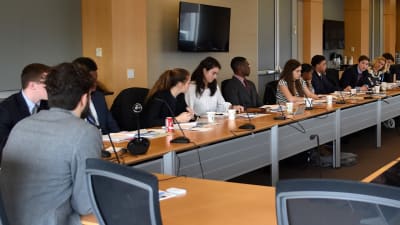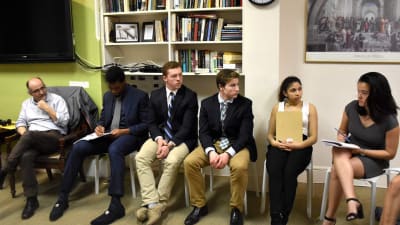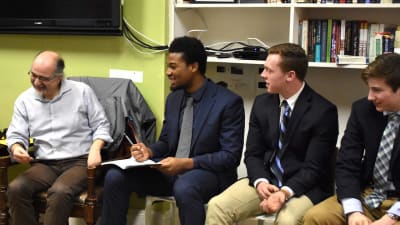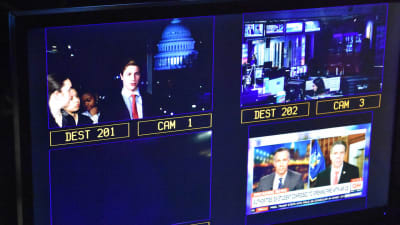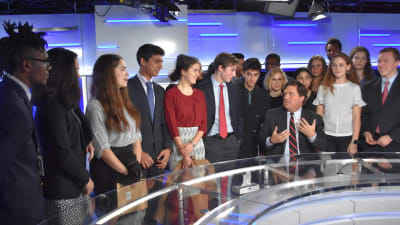Israelis, Palestinians, and the Prospects for Peace
The Israeli-Palestinian Conflict may be the most infamous disagreement in modern history. Not only does it consistently defy the best laid diplomatic plans; it also influences countless related contemporary problems. Leaders of the past and present have worked tirelessly to address it, with limited success. This week–against the backdrop of intensifying tension in the region–our Spring 2018 cohort took its turn, with promising results.
Our students began on Monday with SEGL’s account of Israeli-Palestinian history: the competing promises of T.E. Lawrence and the Balfour Declaration, the competing boundaries in 1948, 1967, and today, the competing visions for the future within Israel and within the Palestinian leadership. This historical account makes every attempt to be unbiased, but we also told the students that many observers on both sides would want to add, subtract, or edit each PowerPoint slide we shared. Skeptical eyes and ears can be valuable when studying issues like this!
Our first visit was to the American Israel Public Affairs Committee (AIPAC), the leading pro-Israel lobbying organization in the United States, where students met with Adam Teitelbaum, AIPAC’s Leadership Development Director. In this capacity, Teitelbaum works with young people around the country to carry out AIPAC’s goals.
Our second visit was to the Council on Foreign Relations, where we met longtime foreign policy expert Elliott Abrams. (CFR recently changed its rules to forbid pictures, but you can view photos from SEGL’s Summer 2017 visit with Abrams here.) Abrams served in numerous foreign policy roles under Presidents Reagan and George W. Bush, most notably as deputy assistant to the President and deputy national security advisor in charge of Middle East policy. (He also spent time as President of the Ethics and Public Policy Center in Washington, DC.) Abrams shared several compelling personal stories from his time in government, along with his “cynical” outlook on the immediate prospects for resolution.
Longtime Palestinian negotiator Ghaith al-Omari, former Executive Director of the American Task Force on Palestine and current senior fellow at The Washington Institute for Near East Policy, joined us on Friday. (He was the 2015 SEGL Golden Mug Award winner!) Al-Omari was at the table for the Palestinians during the Camp David II negotiations and the Taba talks, served as Director of the International Relations Department in the Office of the Palestinian President, and worked as an advisor to Palestinian leader Mahmoud Abbas. His thoughts, delivered in the organized prose of an Oxford-educated lawyer (as he is), made students think hard. Is it better to curse setbacks in the peace process, or do setbacks only underscore the importance of staying engaged? What is the best way for college students to work on this issue? Is it ever right to respond with emotion, or is it better to ask oneself “Will this advance the cause of peace?” before reacting with anger? (Al-Omari, who has worked extensively with Abrams on Mideast peace, testified before Congress the day before his SEGL visit.)
The points of view we heard this week are only a few on a vibrant spectrum. These perspectives, however, gave plenty of fodder for student conversation. How important is honoring opposing narratives in resolving conflict? Are negotiations the best strategy going, forward? If not, what is the best strategy? If so, how do we ensure they are successful? These are just a few of the topics we are considering.
(We also underlined another SEGL truism: if, after a case study, you want to hear a view different from the ones presented, say something! If there is enough interest, we can often arrange for a supplementary speaker later in the semester; if there is not enough interest, any interested student can set up her or his own meetings during a free period. One student has already garnered student support for a videoconference session with an Israeli and a Palestinian whom she met through Seeds of Peace.)
Meanwhile, on Thursday we continued our Media Literacy case study with a visit to DC’s Fox News headquarters to see a live taping of Tucker Carlson Tonight. One of the only media personalities to work for all three of the major cable news networks, Carlson recently took over the 9pm weeknight time slot from Megyn Kelly when she left for NBC last year. After a tour of the headquarters, the students rotated through the on-air studio five at a time–one group per segment–watching Carlson interact with several guests about the day’s top news. The students also got to sit in the control room to see how the show is produced. After the taping, Carlson and his assistant invited all the students to the anchor desk for a brief, high-energy conversation.
Next up: a blockbuster deliverable and two Clinton White House veterans!



